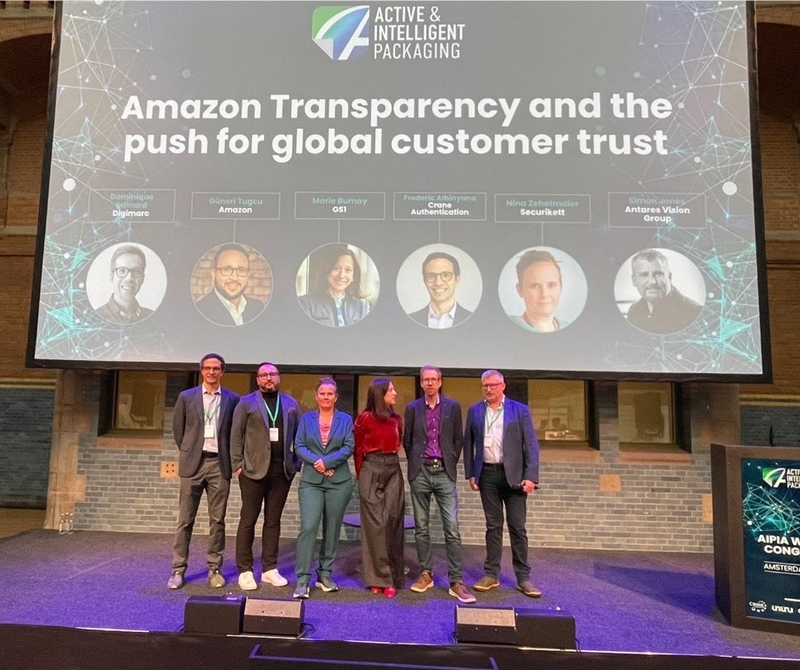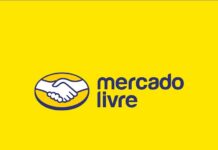Andrew Manly
Transparency
The second day of the Congress kicked off with another major panel presentation dedicated to the topic Amazon Transparency and the push for global customer trust. This featured people from all sides of the subject. Notably Guneri Tugcu, senior partner manager at Amazon joined the group which consisted of Simon Jones of Antares Vision, Dom Guinard, VP of innovation at Digimarc, Nina Zehemair of Securikett and Fredric Albinyana of Crane Authentication. The session was moderated by Marie Burnay of GS1.
Guneri explained that the scale of the problem, both counterfeiting and market diversion was huge. The company deals with 33,000 brands, 900 million products and stretches across many countries. He explained that Amazon was committed to improving the transparency of the products it sold and working with brands to achieve this. “The first step is sometimes the hardest,” he explained. “Sometimes a small, simple solution is better than nothing,” he added.
This lively session was interactive with a number of questions posed to the audience which helped lead the discussion. The first of these posed: ‘What is important as a consumer to trust a brand? Dom Guinard believed visual indicators were still important, but digital features were necessary to make it as hard as possible for counterfeiters, so a multi-layered approach. Simon Jones agreed and added the data smart packaging offers helps brands (and retailers) understand what is happening on the product journey. Other panellists also believed a combined approach offered the best solutions.
Next the audience gave a very mixed response when asked: Is interoperability a key focus in your company? The panel agreed the arrival of Digital Product Passports will force companies down this route, no more silos! Amazon is currently working on a range of regulations which will impact on things such as traceability, said Guneri. While regulations will narrow the timelines it was felt that there needs to be a shift in mindset about the importance of sharing data internally and with others.

A question close to most attendees: What holds companies back from using connected packaging? Not unexpectedly the matter of Cost and Operational Complexity were high on the list. Nina Zehemair reflected the views of many panellists when she said brands should be looking at the ROI not simply the cost. Dom of Digimarc pointed out that connected packaging campaigns had proved to have a better ROI than more traditional marketing. Simon of Antares said the criticism levelled of low engagement was often a misconception when the value of that engagement was assessed and this was reinforced by Securikett who said most of its customers expanded their involvement after seeing the results.
From the floor came a question asked if consumers needed better education about connected packaging. Guneri from Amazon agreed which is why their transparency program was highly visible. That consumers need to get a good experience from making the connection was also a very important factor. It’s up to brands and retailers to help them make that choice easily.
A final question covered Standards and what role they play. Fredric from Crane felt more standards about authenticity might help to drive more engagement. Antares believe standards help with the structure of operational issues. Guneri from Amazon said getting hold of the right people to deal with this topic in big organisations was often a challenge but his company wanted to work with brands to find the best standards for them, not impose their own.
In conclusion all agreed education was vital and the GS1 Digital Link was a good route to standardisation and better adoption of connected packaging.
Innovation Stage
As usual at an AIPIA Congress smaller companies with highly innovative smart packaging solutions were given the opportunity on the Innovation Stage to showcase their technologies. Here are just a few:
Brendan Rice of Senoptica introduced its oxygen sensor, printed directly into the MAP lidding film. Once the product has been packed, the sensor is scanned using an in-line scanning system, providing 100% inspection, he explained. Packs are then accepted or rejected based on the specification for that product. Because the sensor is printed into the packaging, the conditions within the pack can be checked at any point in the supply chain using hand-held devices. This gives retailers the ability to conduct spot checks on all product entering their supply chain and the information which allows for strategic price downs and to reduce food waste.
Co-founder of Safer Smart Labels, Lisa Rita Magnaghi explained about the development of its smart labels, which monitor protein foods freshness by chemical recognition of volatile spoilage markers, communicated to the users by the means of visible and real-time colour transition. The company is a spin off from the University of Pavia and Its solution uses sensing devices to actually enable the monitoring of food freshness with the naked eye.
Pichaya Pattanasattayavong CEO of Thailand based Cleantech & Beyond updated the audience on his company’s Digital Temperature Indicator (DTI) a smart label solution for tracking temperature-sensitive products at item-level. With battery-free operation, the DTI indicates a temperature excursion event both visually and electronically, allowing the status to be monitored manually as well as digitally and wirelessly via RFID/NFC. He announced that the a-Series (from 37°C to 110°C or higher) is now commercially available. The c-Series for cold-chain (4°C to 25°C) will come out next year, around H2 2024.
Smart Food Chain
In a joint presentation Angela Morgan, director, marketing, strategy and business development for Aptar and AIPIA managing director Eef de Ferrante covered how active packaging can mitigate food waste and the introduced the Smart Food Chain Consortium. In an insightful presentation Angela gave a high-level overview of the problem of food waste globally and the technologies that could serve to make an impact. With the amount of food wasted estimated around 30% of production the scale of the problem is huge and, as she explained, different regions face different issues to address the problem – some places need more help at the harvesting/storage/ transportation phase, while others need to offer consumer-based solutions where food is wasted in the home on an industrial scale.
Aptar are one of the leading companies to actually bring solutions to the market, not only in the food sector, but also for sensitive and biobased pharmaceuticals, even for Test kits, etc. The company’s 3-Phase Activ-Polymer™ Material has the ability to incorporate single or multiple chemistries into a polymer solution that retains the performance of the chemistries while maintaining the physical properties of the polymer, she explained.
Channels created within a polymer allow movement of gases. “Active” particles are added to polymer to: Adsorb or Absorb (moisture); Scavenge (gases, odours, reactive impurities, formaldehyde, other VOCs); Release/Emit (aromas, biocides, antimicrobials, nutrients, CO2). Gas diffusion is controlled through the channel composition. The company also produces tailored products for different food types such as FreshWell for fresh produce and SeaWell for seafoods.
The whole food supply chain is under enormous scrutiny just now and AIPIA, in conjunction with consulting organisation Berenschot, is in the process of gathering together a consortium of companies from every corner of the ecosystem to create a Smart Food Chain. AIPIA is preparing the funded initiative to minimize waste in food supply. This will be achieved by developing and implementing effective smart packaging technologies to restructure conventional food supply chains, says de Ferrante.
Funding is being sought under the Key Digital Technologies Joint Undertaking (KDT JU) which is a public-private partnership supporting research, development and innovation in electronic components and systems; and also, from the Strategic Research and Innovation Agenda (SIRA) which has a remit for intelligent logistic systems including sensing and monitoring for food chains. De Ferrante explained that applications to join the consortium are still being accepted and details of the project and an application are available on the AIPIA website. A meeting held during the Congress attracted over 40 companies.



















